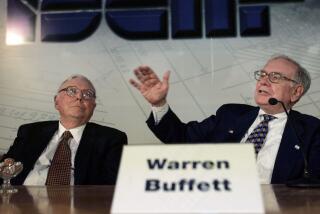When Warren Buffett Comes A-Calling
- Share via
A small El Segundo company that has been in the electronics and computer business since 1952 has become an improbable favorite of sophisticated investors.
Bell Industries recently attracted an investment from Omaha-based super-investor Warren Buffett, who purchased 5.3% of Bell’s stock for roughly $2.5 million. In doing so, Buffett followed a handful of big investors, including Trust Co. of the West, which holds 5.9% of Bell in a special value portfolio.
The attraction? Promise and price. Bell is a relatively small company--$240 million in revenue this year--that sold its original electronics parts distribution business in 1998.
Now, it is mainly in the fast-growing field of systems integration--the Information Age equivalent of management consulting--with a stock price of $5.54 a share, or about nine times next year’s earnings. Analysts regard that as comparatively cheap.
Bell is typical of many companies in Southern California: It is technically oriented, having evolved by hard work and happy accident out of this region’s entrepreneurial and technological history. And today, in ways that hold lessons for business and investors everywhere, Bell faces both great opportunities and the threat of extinction at the same time.
The backing of prominent investors--Bell represents one of Buffett’s first forays in technology--helps lift Bell’s stock price. That in turn gives it the means to acquire other companies and bring them “under the Bell umbrella,” as Tracy Edwards, president and chief executive, envisions it.
Edwards and Chief Financial Officer Russell Doll are eager to expand Bell’s presence in California and the West. Most of the company’s customers and operations are in the Midwest and East, even though it is headquartered here.
But big investors also increase the pressure on Bell. Steel Partners II, a New York investment fund that owns more than 17% of Bell, made an offer in September to buy the company for $5.30 a share. Steel Partners’ purpose was to put Bell up for sale to other systems-integration firms.
Bell’s board of directors, led by Co-Chairmen Theodore Williams, 79, a longtime community activist in Los Angeles, and Gordon Graham, 65, originator of Bell’s computer systems business, rejected the offer as too low.
There is no takeover bid pending at the moment, but clearly Bell has to demonstrate growth and profits if it wants to stay independent.
The company has adapted before. In 1998, Bell was at a crossroads. At less than $700 million in sales, its electronic parts distribution business was too small to keep pace in an industry led by Arrow Electronics, with revenue of $9 billion.
So Bell sold that part of its operation to Arrow, and distributed the proceeds, totaling $7 a share, in payouts to Bell shareholders.
That left the company with a $47-million-a-year business that supplies parts for snowmobiles in the upper Midwest, and the systems-integration operation, which will post around $180 million in revenue this year.
Systems integration is a hot subsection of computer services that is growing 20% a year. As companies in every field rely increasingly on computer links to customers and suppliers and adapt to Internet commerce, there is growing demand for service companies like Bell that can hook everything together and make it work.
Edwards, a 42-year-old former accountant with a business degree from Cal Poly San Luis Obispo, explains the work in nontechnical terms: “Any time you can eliminate the worry from a complex operation, make it a nonissue, you’ve delivered the service” and can make a good living.
“Management consulting is where the trends lead in our business,” Edwards says.
The field is already crowded with such giants as IBM, Andersen Consulting and EDS, as well as small companies such as Alphanet Solutions, CompuCom and Pomeroy Computing.
Bell is comparable in size to the Alphanets and CompuComs, but sells at a somewhat lower price, “even though it has a good list of customers among the Fortune 500,” says analyst John S. Doss Jr. of Dominick & Dominick, a New York investment firm.
Bell got into the field by accident. In 1983, it acquired an electronic parts company in Indianapolis, in which Graham ran a computer services operation. Graham and 40-year-old Christopher Ferry, who runs systems integration today, built the business from there.
The Indiana location has helped Bell acquire such clients as Eli Lilly, the pharmaceutical company, and Indiana and Purdue universities. Bell also has major clients among insurance companies on the East Coast.
But with a current staff of 500 in computer services, Bell must attract more quality employees if it is to grow.
“Attracting and keeping good people is our main focus,” Edwards says.
It’s a field paying good money today--starting salaries above $50,000 a year and rapid ascent in pay and incentives for those with the right skills. “It’s a technical field that demands creativity,” Edwards says.
But with skilled people in short supply everywhere, will a big company acquire Bell simply to inherit its 500 people? Possibly. But computer services, like most new industries, particularly in Southern California, is dependent on people who think for themselves.
“I think most people want to work where they can make an impact,” says Edwards, “and small companies are better in that regard.”
Why is Buffett investing in this company? The sage of Omaha did not return a phone call seeking to ask that question. But portfolio manager Nick Galluccio of Trust Co. of the West, who bought into Bell long before Buffett, thinks he knows the answer.
“Buffett is dipping his toe in technology [$2.5 million is indeed a tiny dip for a man reportedly worth $31 billion], but not by buying Cisco and Yahoo like everybody else,” says Galluccio. “He’s buying value--a small company with a low price and big potential.”
And that’s a description that could be applied to many companies in Southern California.
James Flanigan can be reached by e-mail at jim.flanigan@latimes.com.
More to Read
Inside the business of entertainment
The Wide Shot brings you news, analysis and insights on everything from streaming wars to production — and what it all means for the future.
You may occasionally receive promotional content from the Los Angeles Times.










